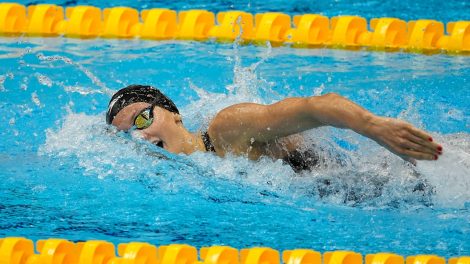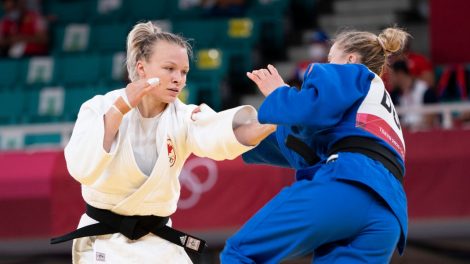The team pursuit—a gruelling event that requires punishing speed and endurance mixed with laser focus—made its debut as an Olympic event at the London Games in 2012. Jasmin Glaesser, along with Tara Whitten and Gillian Carleton, won a bronze medal for Canada in the women’s event.
Glaesser, just 24, is back for more in Rio. She’s joined by teammates Georgia Simmerling, Kirsti Lay, Allison Beveridge and Laura Brown, who was the alternate in 2012. They’ll take to the track as medal favourites—Canada won silver in team pursuit at this year’s world championship and the Canadian team has been on the podium at each world championship since 2012.
But just how does this event work?
The premise is simple enough: Two teams start the race at opposite ends of the track, and the team with the fastest time wins. Each team consists of four riders who make their way around the oval on fixed-gear bikes without brakes. They take turns leading the pack—the rider at the front will expend the most energy—and the goal is to go as fast as you can, though the tactics are more sophisticated than that: Only three riders must finish the race, and if the plan has been executed properly, the fourth will have dropped off by the end. (Teams can also win a race by passing the opponent, though this happens less often in elite matchups.)
Sportsnet spoke with Glaesser to understand more about how team pursuit works, and what to expect in Rio.
The event is different now compared to the last Olympics—four riders instead of three. How does that change affect the race?
Four years ago at the London Olympics, it was a three-kilometre event raced by a three-rider team. And since then it’s changed to be on par with the men’s event, which has always been four kilometres and four riders. It’s great to be able to be on par with what the men have been doing all along.
We’re having to train for a minute longer effort. It may not sound a lot, but that’s a 25 percent longer race, so it’s changed some of the training that we do.
What does the race strategy involve beyond simply going as fast as possible?
There’s a bit of a tactical element to it. You’re trying to use up everyone’s energy in the most effective way possible. Every rider brings something unique to the team. Some riders bring more top-end speed, more power, so we use them up more in early stages of the ride. And then we have a couple key riders that we rely on for that more aerobic component in the last kilometre.
My strength on the team is definitely the closing stages of the race. I’m usually the one finishing it off for our team, but at the same time I’m relying on my teammates to get us up to speed and put down some of that raw power. And then once they’ve done their part I kind of take over from there.
Who’s your biggest competitor in Rio?
There’s a few. Traditionally it was always Great Britain that dominated not just this event but track cycling in general, but they’ve really wavered in the last couple years, just with the depth in the sport really growing—teams like Australia, and this year it was the United States that really stepped up. But we’ve been there consistently now for the last four or five years. We’ve been on every world championship podium, almost every World Cup podium.
Will the race strategy ever change as the rounds go on, or do you stick to the same plan?
You’re always trying to go as fast as possible, but there’s three rounds of competition at the Olympics. So you have the qualifying, a first round and then a second round, which is the medal round. And all of them are almost equally important, but once you get into the later rounds of competition you know what you’re dealing with, and you know what you have to shoot for. It becomes a lot more obvious what other teams are capable of. You can certainly make a lot of guesses before, but you don’t really know until race day.
How can you tell if you’re going fast enough?
Our coach is trackside with us. He’s actually standing on what’s called the pursuit line—the mark on the track that we start our race from. And every time we come around, he’ll signal to us whether we’re up on pace or down on pace, and in the final round of competition, the medal round, he’ll show us how far up or down we are on our opponent. So we get feedback from him every lap, and that’s how we’re able to pace ourselves, to know: Do we need to pick it up? Do we need to be conservative? Are things going to plan right now? That’s certainly a big part of it—being able to respond to the feedback that we get.
At those races, you have a specific lap time—15.5 seconds or 15.6 seconds—and that’s your goal pace. And you really try to stay within one or two-tenths of a second of that. It takes a lot of precision, and certainly a lot of time to be able to nail down that pace that accurately.
Do you talk to each other during the race?
We generally try to give feedback on speed changes if they are necessary. For example, if someone is having a bad turn on the front, communicating to them that they need to pick it up, or vice versa, if they need to steady it out, we’ll yell, “Steady.” And then if that fourth rider pulls off, they’ll yell, “Three riders.” But those are really the only things we communicate. Realistically, when you get to a stage like the Olympics, it’s pretty loud in there and you can’t rely on being able to hear each other. You do have to develop a good feel for it as well and not just rely on verbal communication.
Just how bad is the pain?
It’s definitely a really tough physical event, and you certainly feel that within seconds of starting. That’s when the different strengths come in—some riders will fatigue more as the ride goes on.
At the same time, you still have to pay really close attention and keep track of what’s going on, whether that’s the pace, your teammates trying to communicate with you, or whether it’s having to think about having to adapt under certain circumstances.
On top of that you have that strategic part, and the technical element of having to ride within centimetres of the wheel in front of you. You have to be very focused even as you’re completely emptying yourself.
The women’s team pursuit competition starts Aug. 11.










